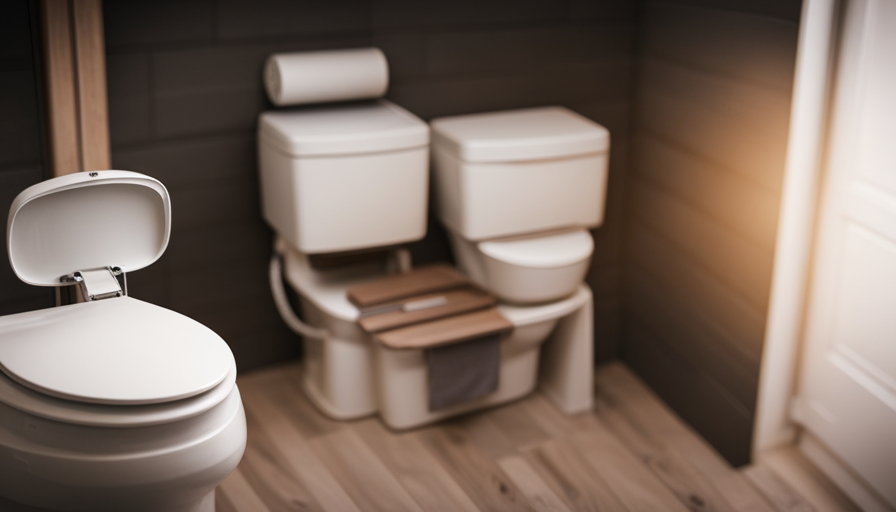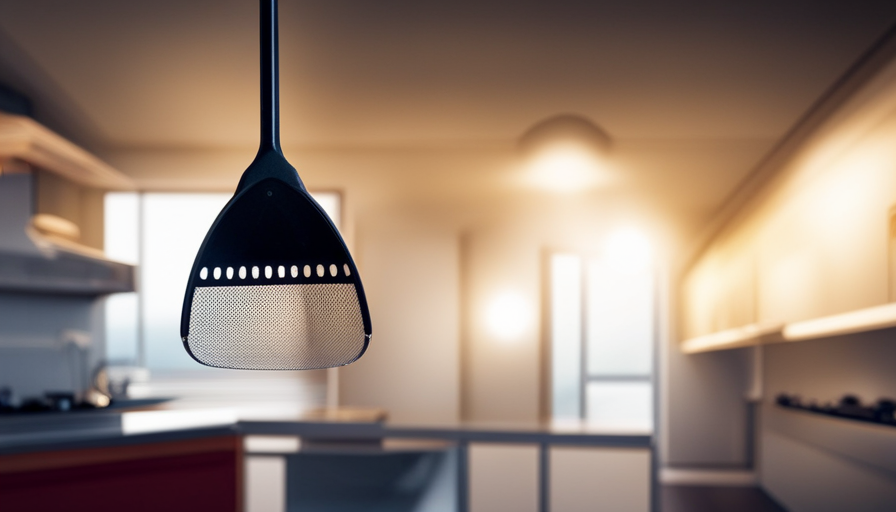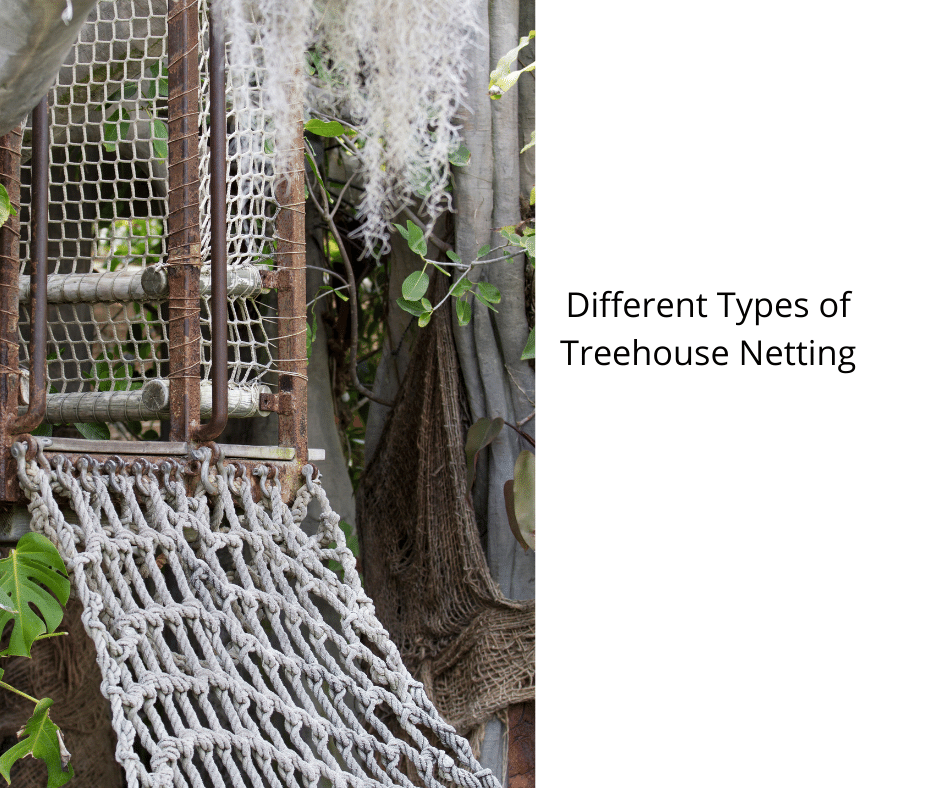Delving into the complexities of plumbing within a small living space, the intriguing aspect of flushing toilets simply cannot be overlooked.
In this article, I will delve into the inner workings of toilet flushing in a tiny house, exploring the various options available and the considerations that need to be made.
From composting toilets to incinerating toilets, waterless toilets to RV-style flush toilets, there is a wide range of choices to suit the unique needs of tiny house living.
We will also discuss plumbing considerations for off-grid tiny houses and maintenance tips to keep your tiny house toilet functioning smoothly.
Join me as we explore the innovative toilet designs and discover the right toilet for your tiny house.
Get ready to flush away the confusion and embrace the technicality and precision of toilet flushing in a tiny house.
Key Takeaways
- Plumbing options for tiny houses include composting toilets, incinerating toilets, waterless toilets, and RV-style flush toilets.
- Composting toilets, incinerating toilets, waterless toilets, and RV-style flush toilets all have unique features that make them suitable for tiny houses.
- Greywater systems can collect and reuse water from sinks, showers, and washing machines in tiny houses, reducing water consumption.
- Off-grid tiny houses can use rainwater harvesting and composting toilets for toilet flushing, further reducing their environmental impact.
Understanding the Basics of Tiny House Plumbing
So, you’re ready to dive into the fascinating world of tiny house plumbing, huh? Well, let’s start by understanding the basics of how everything works, including the all-important toilet flushing system.
In tiny houses, traditional flushing toilets that use large amounts of water are not always practical due to limited space and resources. Therefore, many tiny house dwellers opt for composting toilet alternatives, which are more sustainable and require less water.
One of the main plumbing challenges in a tiny house is finding a way to dispose of waste without a traditional sewer connection. Composting toilets offer a solution by breaking down human waste into compost material that can be safely used in gardens or disposed of properly. These toilets use a combination of natural processes, such as microbial activity and ventilation, to convert waste into a dry and odorless substance.
Composting toilets are not only environmentally friendly but also save water, making them a popular choice for tiny houses. They’re easy to install and maintain, and their compact size fits well in small spaces. Additionally, composting toilets eliminate the need for complex plumbing systems, reducing the overall cost and complexity of the tiny house plumbing setup.
Transitioning into the subsequent section about composting toilets, these sustainable alternatives provide an ideal solution for tiny houses, offering a way to manage waste effectively without compromising on comfort or convenience.
Composting Toilets: A Sustainable Solution for Tiny Houses
Composting toilets are an innovative solution for tiny houses, especially when it comes to managing waste. They work by utilizing a natural decomposition process to turn human waste into nutrient-rich compost.
The benefits of composting toilets in tiny houses are numerous: they save water, reduce the need for septic systems, and provide a sustainable and eco-friendly alternative to traditional flush toilets.
How composting toilets work
Using a composting toilet in a tiny house is like having a miniature ecosystem right inside your bathroom. These innovative toilets are designed to break down waste using a natural composting process, eliminating the need for water or a traditional sewage system.
The key to their operation lies in the balance of organic matter, moisture, and oxygen. When you use a composting toilet, solid waste is mixed with bulking agents like sawdust or coconut coir, which helps create air pockets and absorb any excess moisture. The waste then undergoes decomposition, facilitated by bacteria and other microorganisms.
Regular maintenance is crucial to ensure proper functioning, including emptying the composting bin when it’s full and regularly adding bulking agents. The benefits of composting toilets in tiny houses extend beyond sustainability, offering a low-cost, odor-free, and efficient waste management solution.
Benefits of composting toilets in tiny houses
Imagine having a miniature self-sustaining ecosystem right in your bathroom, where waste is transformed into nutrient-rich compost, saving resources and ensuring a sustainable future for your humble abode. Composting toilets offer numerous benefits for tiny houses, making them an ideal choice for environmentally conscious individuals.
Here are four key advantages of composting toilets in tiny houses:
-
Environmentally friendly: Composting toilets eliminate the need for water, reducing water consumption and protecting precious water resources.
-
Cost-effective: With no need for plumbing or sewage systems, composting toilets save money on installation and maintenance.
-
Odor control: Composting toilets use natural processes to break down waste, effectively eliminating odors and keeping your tiny house smelling fresh.
-
Easy maintenance: Regular maintenance of composting toilets involves simple tasks like adding bulking materials, monitoring moisture levels, and periodically emptying the compost.
Transitioning to the subsequent section about ‘incinerating toilets: a high-tech option for tiny house living’, these composting toilet benefits make them an excellent choice for sustainable waste management in tiny houses.
Incinerating Toilets: A High-Tech Option for Tiny House Living
With incinerating toilets, you can simply sit back and watch as waste is turned into ash through a high-tech process. These toilets are a perfect example of high-tech alternatives that can greatly reduce the environmental impact of toilet waste in tiny house living. Using electricity and extreme heat, incinerating toilets effectively eliminate the need for water and sewage systems, making them an ideal choice for those looking to minimize their ecological footprint.
To better understand the benefits of incinerating toilets, let’s take a closer look at the process. When you flush the toilet, the waste is directed into a combustion chamber. The chamber is then heated to temperatures exceeding 1000 degrees Fahrenheit, effectively incinerating the waste and turning it into sterile ash. This process eliminates the need for water and prevents the release of harmful bacteria and pathogens into the environment.
To evoke an emotional response, consider the following table:
| High-Tech Alternatives | Environmental Impact |
|---|---|
| Incinerating Toilets | Minimal water usage |
| Composting Toilets | Nutrient-rich soil |
| Waterless Toilets | Water conservation |
Moving on to the next section about waterless toilets: saving water in tiny house living, it’s important to note that these toilets offer a practical solution for water conservation without compromising hygiene.
Waterless Toilets: Saving Water in Tiny House Living
After exploring the advanced technology of incinerating toilets in the previous subtopic, let’s delve into the world of waterless toilets, a sustainable option for tiny house living.
Water scarcity is a pressing issue, and in a tiny house, it becomes even more crucial to conserve this precious resource. Waterless toilets offer an innovative solution, eliminating the need for traditional flushing systems and saving gallons of water.
Waterless toilets function on the principle of separating solid waste from liquid waste. They are designed with a composting mechanism that breaks down the waste into organic matter, which can later be used as fertilizer. This process is facilitated by the use of natural additives and proper ventilation, ensuring odor control and hygienic conditions. Furthermore, these toilets are equipped with a fan or ventilation system that aids in the decomposition process by removing excess moisture.
By opting for waterless toilets, not only are you saving water, but you are also contributing to sustainable living. These eco-friendly alternatives are gaining popularity in the tiny house community, as they align with the principles of minimalism and environmental consciousness. With their efficient design and minimal maintenance requirements, waterless toilets are an excellent choice for those seeking a self-sufficient and environmentally friendly lifestyle.
Now, let’s move on to the next section, where we will explore rv-style flush toilets: a compact choice for tiny houses.
RV-Style Flush Toilets: A Compact Choice for Tiny Houses
Step into a world of convenience and efficiency with RV-style flush toilets, the compact and powerful solution for your tiny haven. These toilets are specifically designed for small spaces, making them ideal for tiny houses. Here’s how they work:
-
Compact Design: RV-style flush toilets are designed to fit perfectly into tight spaces. They have a smaller footprint compared to traditional toilets, allowing you to maximize the available floor area in your tiny house.
-
Water Efficiency: These toilets are designed to conserve water, which is crucial in a tiny house where resources are limited. They use a minimal amount of water for each flush, helping you save water and reduce your environmental footprint.
-
Simple Plumbing: RV-style flush toilets have a simplified plumbing system that’s easy to install and maintain. They typically have a built-in holding tank that collects the waste, eliminating the need for complex plumbing connections.
With their compact design, water efficiency, and simple plumbing, RV-style flush toilets are an excellent choice for tiny houses. They provide all the functionality of a traditional flush toilet while taking up minimal space and conserving resources.
Transition: Now that we’ve explored the convenience and efficiency of RV-style flush toilets, let’s move on to the next aspect of waste management in tiny houses: greywater systems.
Greywater Systems: Managing Waste Water in Tiny Houses
Greywater systems are an essential part of managing waste water in tiny houses. These systems are designed to collect and reuse water from sinks, showers, and washing machines. By integrating greywater systems into the plumbing of a tiny house, you can significantly reduce water consumption and minimize environmental impact.
Overview of greywater systems
Toilet flushing in a tiny house is handled by an innovative system that efficiently manages and recycles wastewater, known as greywater. Greywater is the wastewater generated from sources such as sinks, showers, and laundry. It can be treated and reused for non-potable purposes, including toilet flushing.
Greywater systems in tiny houses typically consist of several components:
-
Greywater filtration: The system uses filters to remove debris, hair, and other solids from the greywater, ensuring it’s clean and safe for reuse.
-
Greywater reuse: Once filtered, the greywater is stored in a separate tank and then pumped to the toilet for flushing purposes.
-
Pumping system: A small electric pump is used to transport the greywater from the storage tank to the toilet.
-
Plumbing connections: The greywater system is integrated with the existing plumbing system in the tiny house, allowing for easy transfer and utilization of the greywater.
-
Monitoring and control: Some greywater systems have sensors and controls to monitor water levels and ensure proper functioning.
This efficient greywater system seamlessly integrates with the plumbing in tiny houses, providing an environmentally friendly solution for toilet flushing and reducing water consumption.
Integration of greywater systems with tiny house plumbing
Imagine a harmonious dance between your plumbing and the innovative greywater system, seamlessly blending together to create an eco-friendly solution for water reuse.
Integrating a greywater system with the plumbing in a tiny house involves careful consideration of plumbing regulations and cost considerations. Firstly, it’s important to ensure that the greywater system meets all local plumbing regulations to ensure compliance and safety. This may include requirements for the size and capacity of the greywater tank, as well as the proper disposal of the greywater.
Additionally, cost considerations play a significant role in the integration process. The cost of installing and maintaining a greywater system should be factored into the overall budget of the tiny house project.
With these plumbing regulations and cost considerations in mind, we can now transition into discussing the plumbing considerations for off-grid tiny houses.
Plumbing Considerations for Off-Grid Tiny Houses
When it comes to off-grid tiny houses, you’ll need to carefully consider the plumbing setup to ensure your toilet flushing works efficiently. Off-grid water sources pose unique challenges, but with alternative plumbing methods, you can still have a functional and reliable toilet system.
Here are some key considerations to keep in mind:
-
Rainwater harvesting: Utilizing rainwater as a water source for flushing toilets can help you reduce reliance on external water supplies. Installing a rainwater collection system with a filtration system ensures the water used for flushing is clean and safe.
-
Composting toilets: These toilets are a popular choice for off-grid tiny houses. They use little to no water and instead rely on organic materials to break down waste. Composting toilets are environmentally friendly, odorless, and require minimal maintenance.
-
Greywater recycling: Integrating a greywater system into your plumbing setup allows you to reuse water from sinks and showers for toilet flushing. By diverting greywater to a separate tank or filtration system, you can conserve water and reduce your ecological footprint.
Considering these off-grid water sources and alternative plumbing methods will help you create a sustainable and efficient toilet flushing system for your tiny house.
In the next section, we’ll explore maintenance and cleaning tips for tiny house toilets, ensuring your system remains in optimal condition.
Maintenance and Cleaning Tips for Tiny House Toilets
Taking care of your tiny house bathroom is like tending to a delicate garden, requiring regular maintenance and cleaning to keep things running smoothly. When it comes to maintaining your tiny house toilet, there are a few maintenance tips and cleaning techniques that can help ensure its longevity and functionality.
Firstly, it’s important to regularly inspect your toilet for any signs of leaks or damage. Check the seals and connections to make sure everything is secure and in good condition. If you notice any leaks, address them promptly to prevent further damage.
Cleaning your tiny house toilet is also crucial for maintaining a hygienic and odor-free bathroom. Use a mild cleaning solution and a soft brush to clean both the inside and outside of the toilet bowl. Pay extra attention to the areas around the rim and under the seat where bacteria can accumulate.
Additionally, it’s recommended to use biodegradable toilet paper and avoid flushing any other materials down the toilet, as this can lead to clogs and other plumbing issues.
By following these maintenance tips and cleaning techniques, you can keep your tiny house toilet in optimal condition. Now, let’s explore innovative toilet designs for tiny houses, which offer even more efficient and space-saving solutions.
Exploring Innovative Toilet Designs for Tiny Houses
Get ready to discover the latest toilet designs that’ll revolutionize your tiny house bathroom and maximize your space.
When it comes to tiny house living, every inch counts, and that includes the bathroom. Fortunately, there are innovative space-saving toilets available that are perfect for tiny houses. These toilets are designed to be compact yet functional, allowing you to make the most out of your limited bathroom space.
One popular option is the composting toilet. This alternative toilet option eliminates the need for water and plumbing, making it ideal for off-grid living. Composting toilets use natural processes to break down waste into compost, which can then be safely disposed of. They’re odorless and easy to maintain, making them a great choice for tiny houses.
Another innovative toilet design is the macerating toilet. This toilet uses a macerator pump to grind waste into a fine slurry, which is then pumped into the plumbing system. Macerating toilets are compact and can be installed in tight spaces, making them perfect for tiny houses with limited bathroom space.
Now that you know about these innovative toilet designs, you can start considering which one’s the right choice for your tiny house bathroom. From composting toilets to macerating toilets, there are plenty of options to choose from. Stay tuned for the next section, where we’ll explore the factors to consider when choosing the perfect toilet for your tiny house.
Choosing the Right Toilet for Your Tiny House
When it comes to choosing the right toilet for your tiny house, there are several options to consider. One popular choice is a composting toilet, which eliminates the need for water and sewage connections. These toilets use a natural decomposition process to break down waste into compost, making them environmentally friendly and easy to maintain.
Another option is a compact flush toilet, which operates similarly to regular toilets but with a smaller profile. These toilets require a water connection and a sewage system, so proper installation is crucial.
Installing a toilet in a tiny house requires careful planning and consideration. First, you’ll need to determine the best location for the toilet based on the layout of your tiny house. Consider factors such as access to water and sewage connections, as well as the proximity to other living spaces.
Additionally, you’ll need to ensure proper ventilation to prevent any odors or moisture buildup. Installing a vent fan or window in the bathroom can help with this.
Overall, choosing the right toilet for your tiny house and ensuring proper installation is essential for creating a functional and efficient bathroom space. Consider your options carefully and consult with professionals if needed to ensure a successful and hassle-free toilet setup.
Frequently Asked Questions
Can I use a regular flush toilet in a tiny house?
Yes, you can use a regular flush toilet in a tiny house, but there are alternative toilet options to consider. One popular option is a composting toilet, which doesn’t require water and uses a natural composting process to break down waste. The pros of composting toilets include water conservation and the ability to create nutrient-rich compost. However, they do require regular maintenance and can have a higher upfront cost.
Are there any regulations or codes I need to follow when installing a toilet in a tiny house?
Oh, the joy of dealing with building codes and plumbing regulations when installing a toilet in a tiny house! It’s like a thrilling adventure that brings out the engineer in all of us.
The process involves carefully navigating through a maze of regulations, ensuring proper waste disposal, and meeting all the necessary standards.
From sizing requirements to venting systems, every detail must be meticulously planned to ensure a functional and compliant toilet installation.
How do composting toilets work and are they suitable for all tiny house setups?
Composting toilets are a practical and eco-friendly option for tiny house setups. They work by breaking down waste into compost through a natural decomposition process. These toilets have several benefits, including water conservation and minimal odor.
To maintain a composting toilet, regular maintenance is required, such as adding bulking agents like sawdust and ensuring proper ventilation. Additionally, the compost produced can be used as a nutrient-rich fertilizer for plants.
What are the advantages and disadvantages of using an incinerating toilet in a tiny house?
Advantages of using an incinerating toilet in a tiny house include efficient waste disposal, as it burns waste to ashes, eliminating the need for water or plumbing. It also reduces odor and requires minimal maintenance.
However, there are some disadvantages to consider. The high energy consumption of incinerating toilets may be a concern for those seeking to minimize their environmental impact. Additionally, the initial cost and limited capacity for waste storage may be drawbacks for some tiny house owners.
Are waterless toilets a practical option for year-round use in a tiny house?
Waterless toilets, such as composting toilets or incinerating toilets, can be practical options for year-round use in a tiny house. These alternative toilet options eliminate the need for water flushing and are designed to efficiently manage waste. Composting toilets use natural processes to break down waste into compost, while incinerating toilets burn waste into ash. Both options require regular maintenance and proper ventilation to ensure odor control and effective waste management in a tiny house setting.
Conclusion
In conclusion, when it comes to toilet flushing in a tiny house, there are several options available. From composting toilets that offer sustainability to incinerating toilets that provide a high-tech solution, there is a toilet design to suit every tiny house owner’s needs.
Waterless toilets offer a way to save water, while RV-style flush toilets are a compact choice. It’s important to consider plumbing considerations for off-grid living and to maintain and clean toilets regularly.
With the wide range of innovative toilet designs available, it’s essential to choose the right one for your tiny house to ensure optimal functionality.
Hi, I’m Emma. I’m the Editor in Chief of Tiny House 43, a blog all about tiny houses. While tree houses are often associated with childhood, they can be the perfect adult retreat. They offer a cozy space to relax and unwind, surrounded by nature. And since they’re typically built on stilts or raised platforms, they offer stunning views that traditional homes simply can’t match. If you’re looking for a unique and romantic getaway, a tree house tiny house might just be the perfect option.










